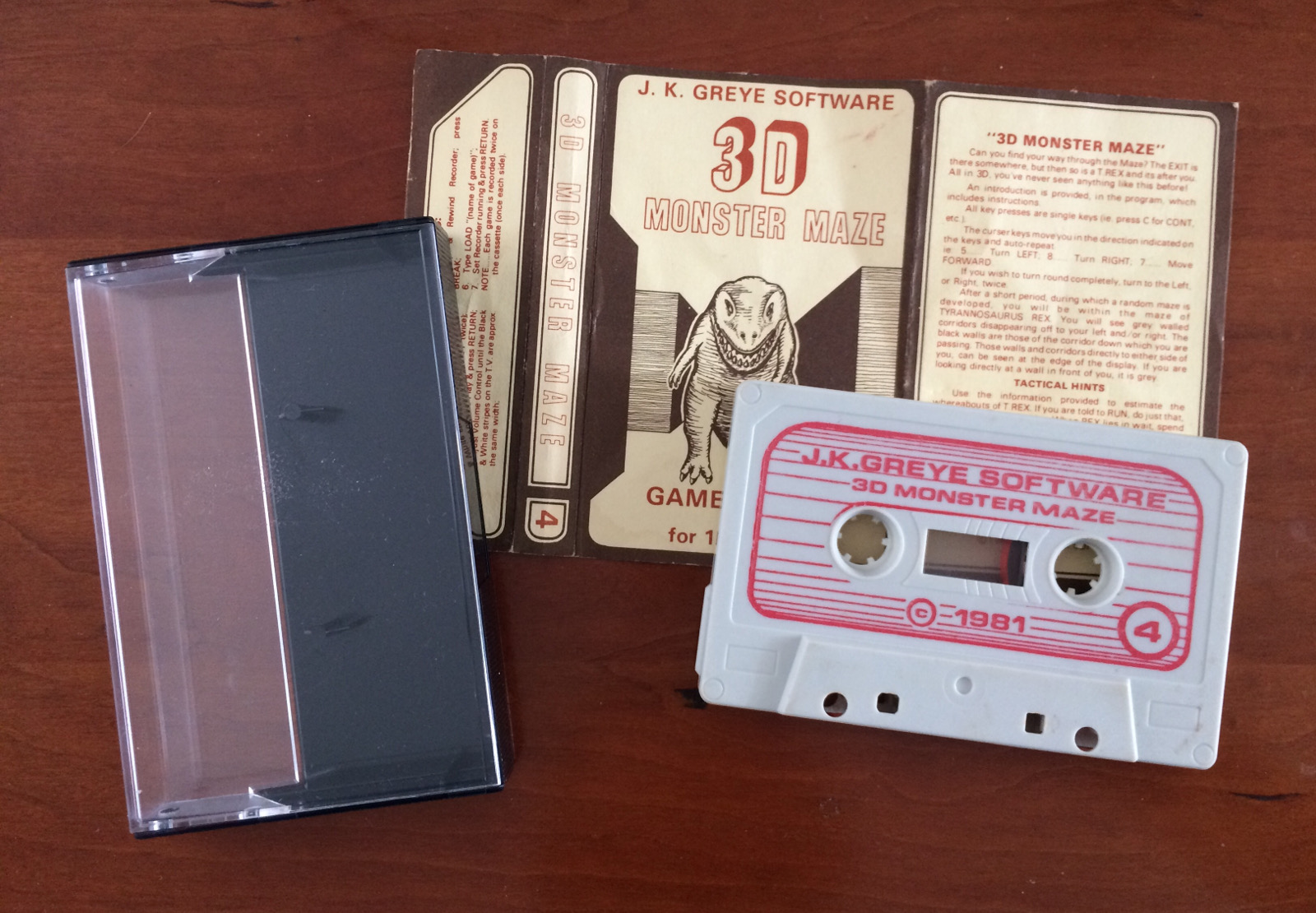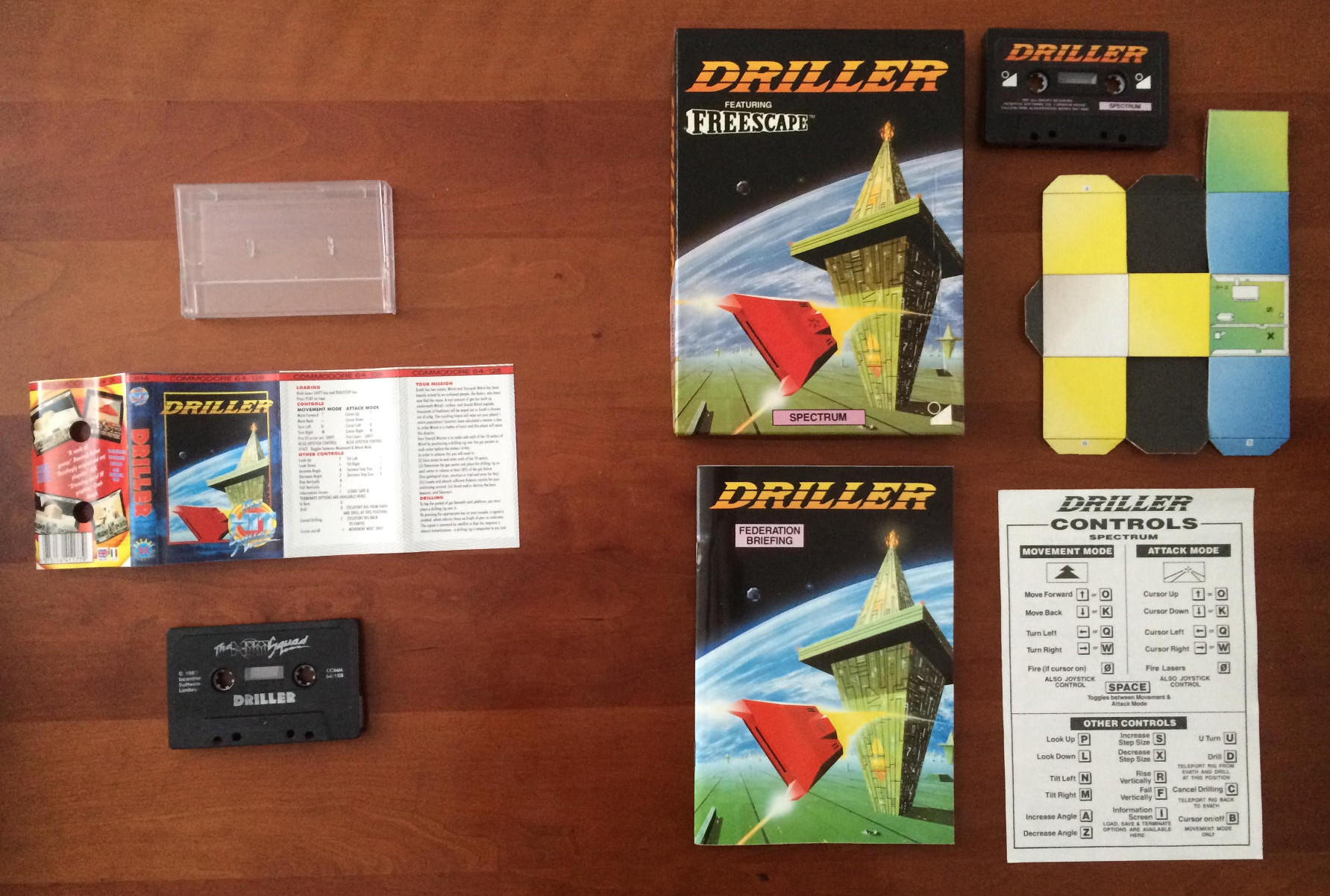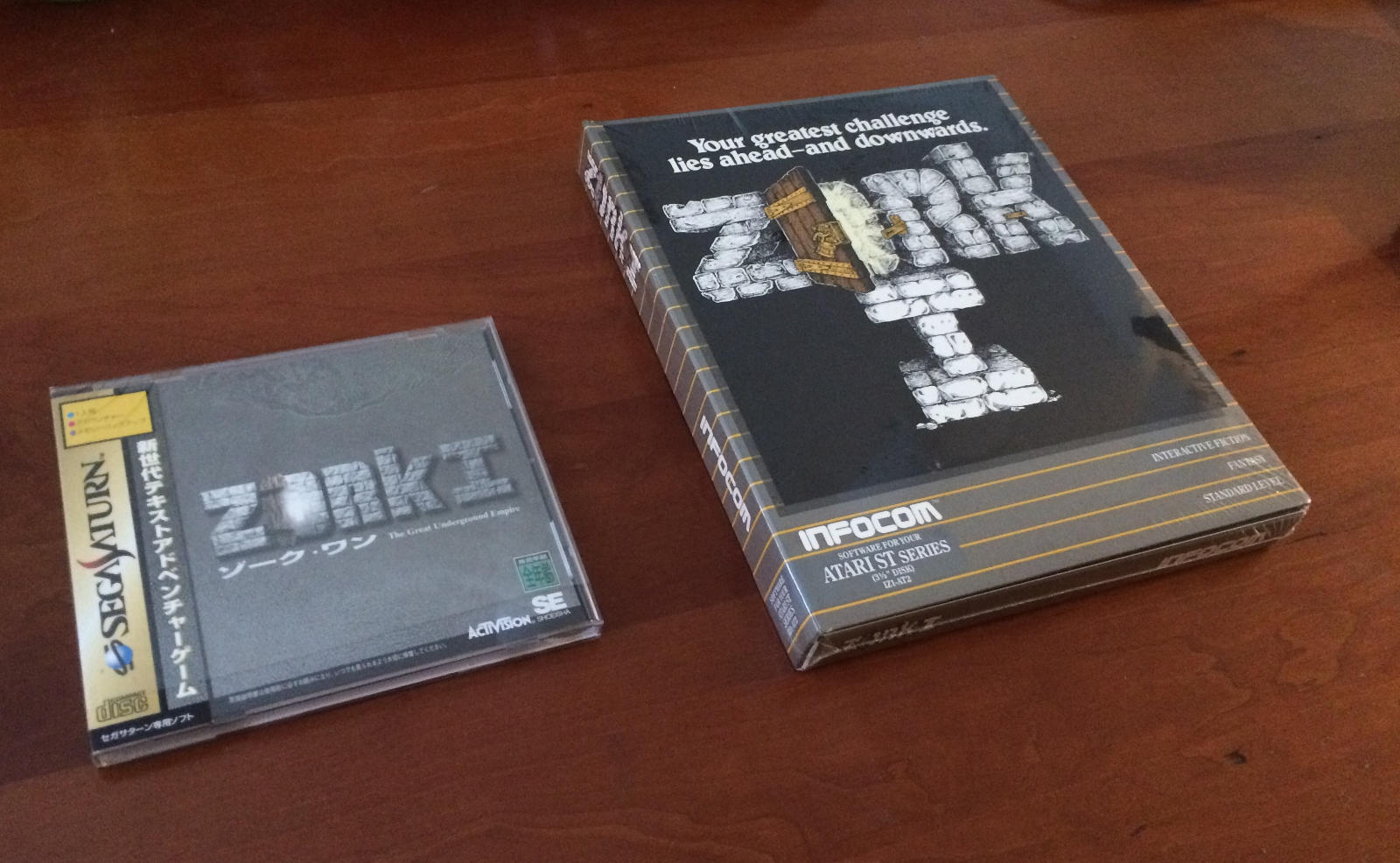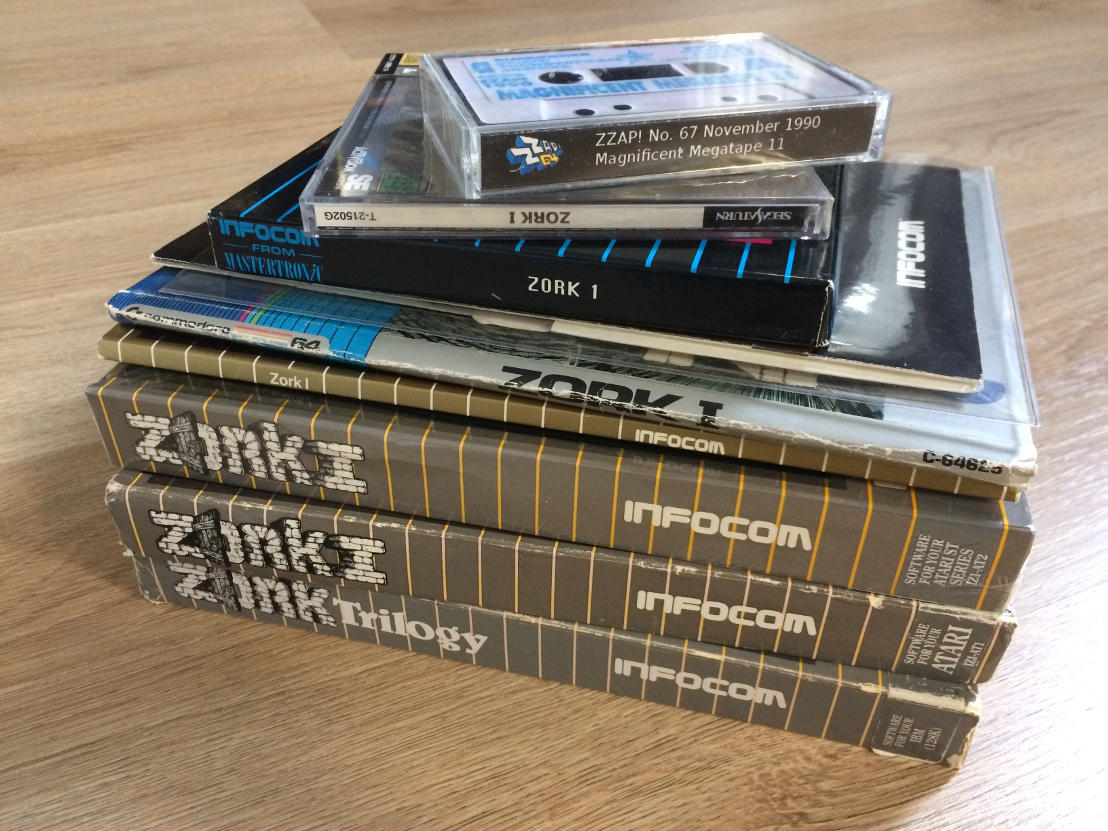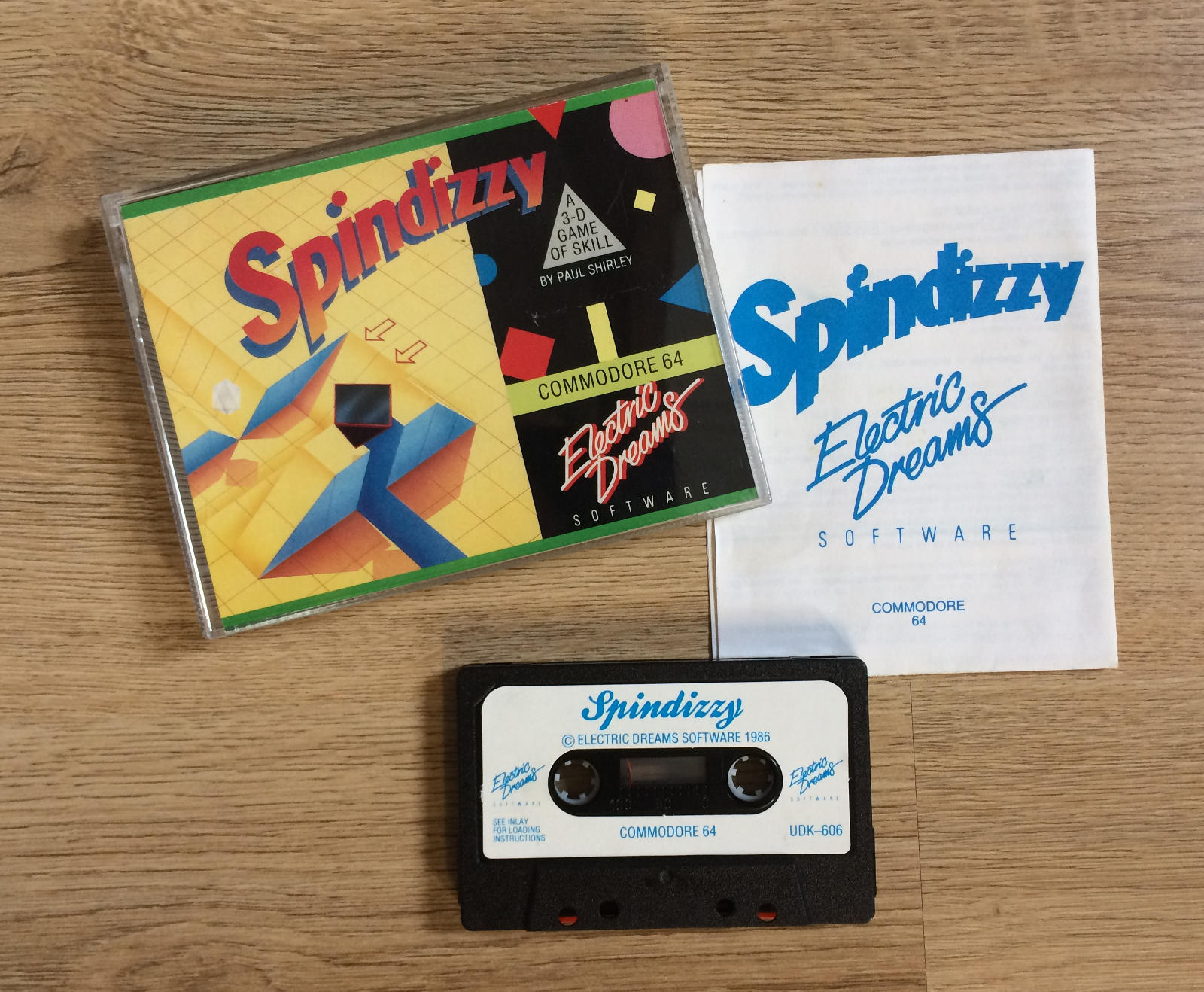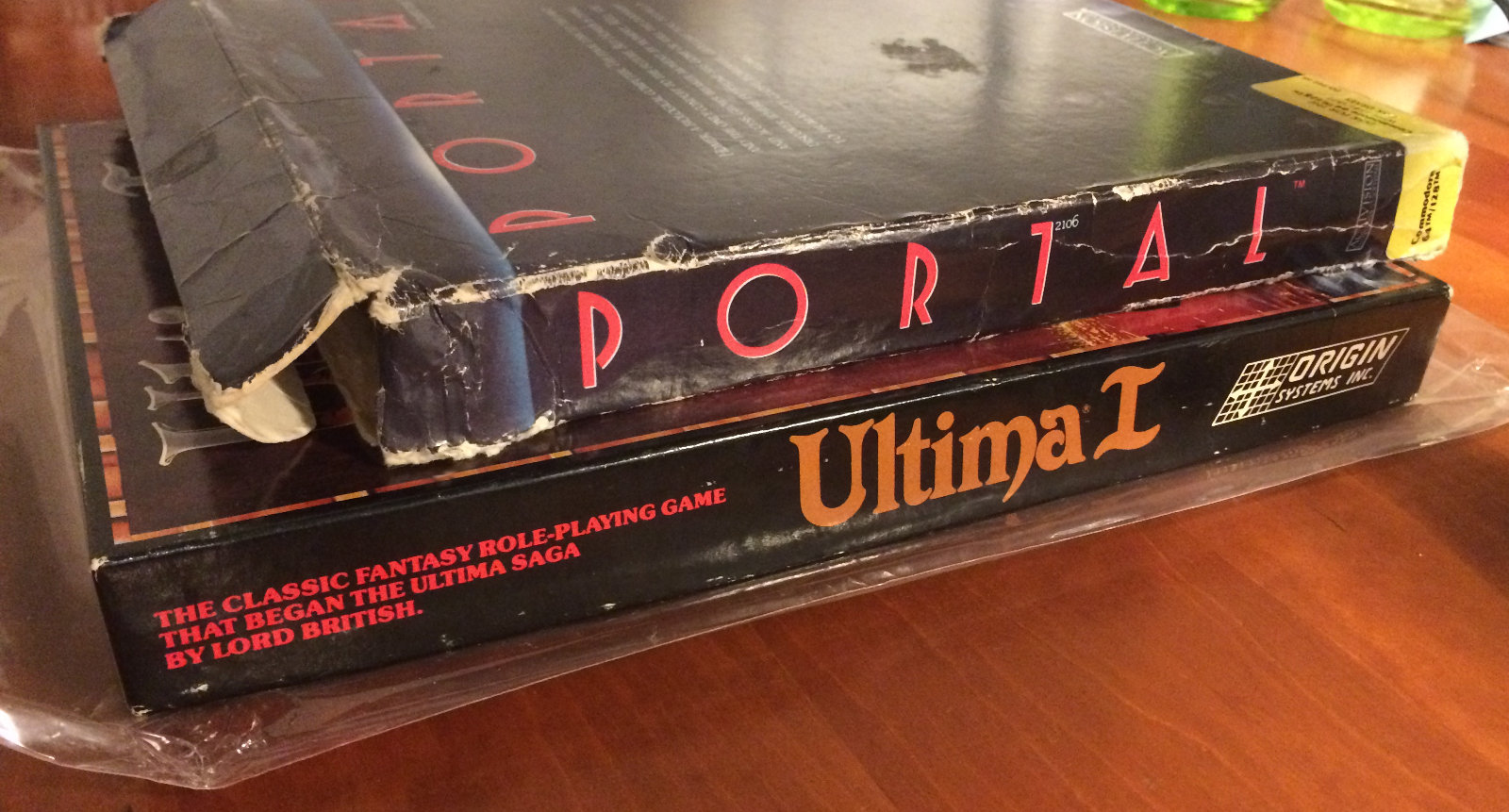
|
||||||||||||||
|
Retrogaming |
On collecting vintage computer games(For home computers and personal computers)In which several observations are made involving the coveting, acquiring, collecting, and eventually recklessly amassing of home computer and personal computer games that were published in the period between 1977 and 2000. After an outline of computer and console game history, a number of issues are discussed, such as: Who collects computer games? What sets the older games apart from the newer? Are all games from this period collectible? Can these games still be played in the twenty-first century? What could possibly go wrong?
Contents
1. A brief historical overview 1. A brief historical overviewDescription — Early computer games — Enter the mercantile age — Console versus general purpose computer — Packaging 1.1 DescriptionExplaining the notion of a computer game may seem like a superfluous undertaking in today's virtualized society; nevertheless I point out some characteristics here before I embark upon the discussion of trivia connected to collecting these games. Computer games — also known as video games — are understood to be software meant to provide entertainment by means of interaction with a computer. The player is confronted with a situation in a simulated world — primarily through a display, but exceptions exist — and can react to or manipulate the situation using some controller, such as a keyboard, a mouse, or a joystick. The software may portray a simplified, schematic, stylized, or highly detailed and realistic environment, in which the player may be represented by employing a first person or third person perspective. There may be an explicit and specific goal that must be reached through repeated and dedicated play in a highly dynamic environment, or the game may take the form of a story, the unveiling of which is similar to a journey where the player meets problems or puzzles that he must solve to reach its conclusion. Others still may be simulations of activities that exist in reality, such as flying an aeroplane, operating an army tank, or presiding over the rise and fall of an entire empire. Over the years very many titles of great diversity have been published. They can be purchased or downloaded as freeware or abandonware and be run on a suitable computer at the discretion of the player. They are also usually played one at a time, as they require application of the senses and a concentrated mind. Some games offer a social aspect when they can be played with or against several other players. This text focuses on classic computer games. What is called classic is subjective, but here I address games that were published in the period between the introduction of the home computer in 1977 and the decline of the big box, and the emergence of the PC with Windows 95 as the dominant game system-on-the-desk in the second half of the 1990s. The platforms considered are mainly home computers and personal computers, as the greatest variety of packaging — an important factor in this field — can be found there. 1.2 Early computer gamesDedicated devices for personal entertainment have existed for several centuries, but until the advent of the modern computer these were made to suit a particular game, such as the electromechanical pinball machine, or the one-armed bandit, or the alleged "Mechanical Turk" chess machine. It was the ability of the electronic computer to store not only digital data, but also the programs that could manipulate and produce these data, that provided the framework and flexibility necessary for both the development and the running of more elaborate and diverse games on a single machine. The evolution of computer games accompanies that of the electronic computer itself. In a time when computers for the home did not yet exist, the first computer games were written for mainframe architectures and so-called minicomputers; costly and physically large machines that were invented and used in universities and large high-tech companies. These first games were sometimes intended as demonstrations of new technologies, but in other cases as a personal diversion of programmers. Famous pioneering efforts were Space War! on the Digital PDP-1 (1962), Maze War on the IMLAC PDS-1 (1974), the Colossal Cave Adventure — or ADVENT — on the Digital PDP-10 (1976), and The Oregon Trail on the Hewlett-Packard HP 2100 (1971). The time sharing mechanism that many of these machines utilized gave rise to the first multiplayer games, while the sober text representation of some efforts accommodated porting to other systems. 1.3 Enter the mercantile ageAppreciating the commercial potential of this new form of entertainment, companies started to develop specialized machines in the guise of coin-operated cabinets that enabled the general public to play computer games. These cabinets were installed at venues where they would attract players, such as amusement arcades already populated by pinball machines. An arcade cabinet would typically hold only one game title; to play another, the player would simply move to another cabinet. Computer Space (1971) by Syzygy Engineering (later Atari) and Pong (1972) by Atari are famous examples; Taito's Space invaders (1978) is another. The first games console intended for home use was the Magnavox Odyssey. Released in 1972 and predating the Pong arcade cabinet, it was to be connected to a television set where it would display monochrome "dots" that could represent moving objects. No score was kept by the console, and colors were simulated by placing overlays on the TV screen. Consoles of this type were later known to be examples of the "first generation" of consoles. With the appearance of the second generation, consoles were equipped with a microprocessor (or CPU) and sported various other improvements, such as multiple colors and multichannel sound. The most prominent member of this generation is the iconic Atari 2600 (1977). Portable or "handheld" game consoles appeared thereafter. 1977 also saw the introduction of a famous trio of "home" computers1: the Commodore PET 2001, the Radio Shack TRS-80 Model I, and the Apple II. These machines and their successors were intended for home use as well, but had a much broader range of applications and could be regarded as domestic versions of professional machines. They had a keyboard, could be programmed by the user (notably through the built-in high level language BASIC), and programs and data could be read from and stored on floppy disk and cassettes. Enthusiastic individuals working on their own soon made games for their machine — original or derivatives of existing arcade titles — starting a cottage industry that quickly grew into an international business that is dominated by big software companies, adding production value and cultural weight. As the 1980's progressed, various 8-bit platforms came and went, eventually being supplanted by machines based on 16-bits and 32-bits processor technology such as the Amiga, the Atari ST, and the IBM PC and compatibles. Although the IBM PC was originally not designed to be a gaming machine, its open architecture allowed the addition of graphics and sound boards with which it achieved dominance in this field in the early 1990s. 1.4 Consoles versus general purpose computersSubsequent years brought technical improvements to both consoles and home computers; screen resolution, number of sound channels, number of colours, memory size, processor speed. However, the two types remained distinct. Consoles remained specialized game computers, shaped for its single application. They are used with a TV screen, and normally placed under or next to the latter. Controllers are designed for the manipulation of the player's on-screen representation whose main purpose is to move. Software is loaded from read-only media: cartridges containing a ROM chip, or CDs or DVDs. A general purpose computer offers more varied uses — at least potentially — and the peripherals to support them. The machine is used with a dedicated monitor and is placed on a desk leading the user to assume an office worker's pose. The keyboard is the main input mechanism, and media are made for reading and writing, such as floppy disks (in the earlier generations), USB drives, and hard disks, although from the late 1990s until the early 2010s optical media were common for installation of software. It's still true that the user can write his own software on a PC, but not on a console. Interestingly, these computers could and can also be used to illicitly copy software as well; a major concern that had consequences. Are the differences between the two paradigms conducive to different game types? As mentioned above, the respective controllers are fundamentally different. the fifty or more keys on a keyboard2 and the precise positioning by the mouse enable a wide range of possible manipulations of the game state, especially necessary in realistic simulators. Another case where the keyboard is a necessity is the old form of the text adventure, which uses a rudimentary form of text analysis to control the protagonist. Without going into the matter more deeply, it seems that one can say that there are some games that require involvement and conquering a learning curve that sit well on the office chair and not on the sofa. Furthermore, some popular franchises are bound to a particular console manufacturer: Mario to Nintendo, Gran Turismo to Sony, and Halo to Microsoft. There is some mutual ground as well; Doom, Myst, Tetris, and Monkey Island are popular titles that appeared on both types (and are played using simple controls). 1.5 PackagingPresentation is an important matter in the undertaking of selling a product. As the development of games gathered steam and became commercially attractive, packaging became more elaborate.
Early home computer games were sold in simple packaging. In the Get Lamp documentary, text adventure pioneer Scott Adams relates some of his own experiences. For Adventureland (1979), one of the first titles in the Adventure International catalogue, a small transparent plastic bag was used with the open end closed by stapling a folded business card over it. Inside would be room for a cassette tape and a short printed or copied instruction manual. Similarly, the first editions of Ultima I (1981) were sold in ziploc bags, holding a 5¼" diskette and a manual.
Another type of low-cost packaging was that of the standard cassette case. These were already in use for audio cassettes but were also practical for the distribution of software on the same medium. Instructions and other pertinent information could be included by way of the inlay, also known as "J-card" or "U-card" (with extra panels if necessary), or sometimes a small separate leaflet was added. This form was used throughout the period in which cassette tapes were used as a distribution medium, ending in the early nineties — by this time mostly for budget titles. Larger versions of the case also appeared, to accommodate two cassettes side-by-side, or 3½" diskettes for Atari ST and Commodore Amiga games.
Soon cardboard boxes became the dominant container, bringing capacity, some degree of sturdiness, and enough exterior surface for elaborate artwork, screenshots, and — increasingly important — a list of system requirements. This is the form to which the term "big box game" refers. These big boxes afforded the publisher the possibility to furnish games with non-digital additions, such as big manuals and other printed matter to provide additional context and immersion on account of the absence of high-resolution graphics or on-screen narrative capacity on early media. Game-related maps, novellas, cards, audio tapes, and other trinkets were also included in premium titles, such as those from Origin (the Ultima series) and Infocom (who called such objects "feelies"). In some cases the information in paper manuals was employed as a copy-protection or anti-piracy scheme, as the effort of copying an entire book of tens or hundreds of pages was naturally deemed unattractive.
First editions or special editions sometimes came in unusal boxes, such as Lucasarts' triangular Day of the Tentacle, ID's metal Quake III Arena, and Infocom's flying saucer-shaped Starcross. The last phase in the commercial life cycle of a big box game is the budget repackaging. After perhaps several years have passed since its introduction and sales have slowed, publishers may decide to repackage a game in a simpler and cheaper format. The necessity of any add-ons will then be reconsidered and big boxes might become small boxes. An example to illustrate this is the 1987 game Driller. The original box included a short novel and a folded model of a rhombicuboctahedron that represents the game world. The budget version comes in a standard cassette case with the instructions condensed to a minimum to fit on the U-card inlay. The lavishness has been cut, but the game should still be playable.
Console games were normally published by the manufacturer of the hardware. A standardized simple cardboard box accomodating a cartridge or a standard plastic CD jewel case or DVD keep case was used for most games (in the late 2000s and early 2010s, budget releases of PC games were also packaged in DVD-style keep cases). In cases where big box computer games were converted to consoles, any tangible additions to the original were not usually included with console conversions.
Towards the end of the nineties the big box format saw a decline. Perhaps the reason for this is that with the arrival of high-capacity media and improvements to multimedia aspects of the modern PC the necessity to include augmentative paper artwork dwindled, and that instructions were often incorporated in the game itself in the form of on-line help or a tutorial. Many games would still be published in big boxes, albeit with an increasing amount of air within. A Game like Myst (1993) would be a mostly big empty box with a CD inside. Eventually more and more often the packaging format would revert to media-fitting plastic poly boxes and most recently, just a screenshot and a download code in an e-mail.
2. Collecting computer gamesWhy collect? — Mighty oaks from acorns grow — Playing versus collecting — Acquisition 2.1 Why collect?It is tempting to simply attribute collecting games of twenty years or older to feelings of nostalgia, one of the trappings of middle age. There are however some other facts worth pointing out. One matter is that of tangibility. The box is a concrete item; the tactile experience, together with the artwork on the front and various additional inserts, becomes something desirable. Consider as an illustration the following, quoted from an ebay auction for a new and shrinkwrapped copy of Synapse's The Pharaoh's Curse:
It is possible for a collector to collect simply as an investment, speculating that a particular title or series may increase in monetary value due to rarity and age. And otherwise there is still the satisfaction of obtaining another coveted title. Another matter is that by virtue of more primitive hardware older games offer a greater separation between the real world and the virtual world. This counters the technological progression of sound and video hardware, but it requires creativity of the coder and leaves more room to engage the player's imagination. A related point is that more modern games, even those that appear small, such as apps on a smartphone, are the products of entire teams of programmers and artists. In contrast, classic games — especially those from the early 8-bit period — could be invented, designed, written, and published by a single programmer on a machine that could be entirely understood by the same individual. With today's "maker"subculture, this will certainly resonate. The final issue mentioned here is that of ownership. A boxed game, and specifically the digital medium accompanying it, is irrevocably the property of the buyer once it is paid for. It should therefore always be possible to play it, provided the required hardware (or emulator) is available and functioning. Modern user-oriented computing however shows a tendency to "move to the cloud". The massively multiplayer online genre is a closely related development, where players are dependent on remote servers on which the game databases are run and administered by the vendor of the game, often in return for a monthly fee. A consequence of this subscription-based approach is that availability is dependent on external factors; for example, when a game is considered commercially moribund, the necessary online infrastructure may be dismantled, leaving the player unable to play the game. In theory, it is even possible for a game — or software in general — to "phone home" and delete itself if some dystopian policy would require such. Sometimes independence from the Internet is an advantage. 2.2 Mighty oaks from acorns growDespite these considerations, it is likely that most collections are not started intentionally. A collector may initially have had no desire at all for amassing large numbers of games, but if he found a liking for the art form in his younger years he may find that he has retained his appreciation as he traverses the byzantine and sometimes downright irritating obstacles of professional life, even if the prime of his erstwile gaming platform lies in the far past by this time. If and when his old interest has been retriggered some way or another, it will be easy to restart a former hobby with the abundance of online auction sites and specialized forums. If tended to with an unrestrained appetite, an existing collection may keep growing in one or more directions; items will be added that are in some measure abundant, or are presented by acqaintances clearing house, or come from other sources of opportunity. There is the archivist collector type — a preserver of the entire breadth of the medium — for whom any addition is welcome, but the specialized collector will defy this tendency and set the waypoints of his journey himself. In the very long list of published game titles, he may find a theme that suits his interests or a particular publisher that appeals to his sense of aesthetics and devote his energies thusly. Whether a particular game has a potential for collectibility is therefore entirely up to the collector and his motives. One may for instance be interested in flight simulation, and especially the subcategory concerning military jet aircraft. The collector has now found his theme. Within the bulk of all games published across the decades, there are several strata of relevant titles. In the 1980s Microprose was a leading publisher, while in the 1990s Spectrum Holobyte and Jane's Combat Simulations and others gained the foreground. Of course, if the collector is based on a certain platform (in order to be able to play them on a single machine), this limits the choice of available games. A collection may also be limited to a single title. Infocom's Zork I for instance, has appeared in at least 9 packaging styles (not counting compilations), while ports exist for perhaps as many as twenty different platforms. On the other hand, Ant Attack by Quicksilva appeared only for the ZX Spectrum and the Commodore 64; a much more manageable scope.
2.3 Playing versus collecting and emulation versus vintage hardwareThe original purpose of a computer game is to provide entertainment. In the activity of collecting games, however, the focus on obtaining and caring for the physical items themselves may let actually playing them to gradually move to the background. There is of course no objection to this; a stamp collector generally doesn't use his British Guiana "One Cent" to mail a birthday card either (to give an inaccurate but fun analogy). Should the collector want to play his acquisitions, then he must deal with the fact that aging games were made for computers that are aging as well. Both the medium and the host machine are now beginning to suffer from the ailments typical for electronic technology: leaking capacitors, yellowing plastics, degrading keyboard membranes, perishing drive belts, and oxide-shedding magnetic media. A number of these issues can be solved by a tech-savvy owner, but disks and cassettes that have become unreadable due to their losing the capacity to retain data cannot easily be rescued. Owners of a certain game may however venture upon the Internet and find that some other user has archived the same title as a so-called image — a file or files containing bit-for-bit copies of the contents of the original data carriers — and placed it in some repository on line. It may even be considered advisable for the owner to make these back-up images himself for his own use, provided he has the appropriate equipment. Fortunately, a large part of original software has been archived as so-called images — files containing bit-for-bit copies of the contents of the original data carriers. These can be found for many vintage platforms in various repositories on the internet.
Such an image can be used in a number of ways. It can be loaded into an emulator of the relevant platform, or be transferred to a functioning instance of its original medium and used with a vintage computer and relevant storage device, or, again in the guise of an image, be used in conjuction with a modern storage device replacement that mimics a disk drive or cassette recorder but uses SD cards or USB drives for storage. This solution is quite transparent, except when the software prompts the user to swap disks; the transformed procedure for images is slightly different. Caring for legacy machines is a rewarding pastime in itself and bears similarities to maintaining a collection of classic computer games, although it is more technical in nature. Some enthusiasts argue that for a full "retro experience", a game must be played on original hardware. Keyboard layouts may differ from modern PC incarnations for example, which is relevant for certain games. Furthermore, according to some enthusiasts visual effects that are native to CRT monitors and the particular sound of original audio chips are not entirely accurately reproduced via emulation. Especially in the demo scene there is some extra prestige derived from showing the latest algorithms on unmodified vintage computers. But emulation has a number of important advantages. The recent past has shown a steady increase of prices asked for some common vintage computers, such as the Sinclair ZX Spectrum, the Commodore 64, the Commodore Amiga, and the variants of the Apple II. More exotic platforms such as the Tatung Einstein or the SAM Coupé have become difficult to find and are even more costly. With the great number of well-developed emulators the need for increasingly rare and expensive machinery and the necessary maintenaince, just to be able to use a particular title, disappears. Apart from pecuniary considerations, emulators have become truly capable replacements for the originals, even replicating such phenomena as disk drive sounds and screen interlacing. The flexible configuration of the virtual machine surely must be the most appealing feature. At no extra cost, extra memory can be added or disabled, emulated disk drives added or removed, obscure toolkits installed, and the PAL/NTSC schism that plagues some internationally successful platforms can be solved with a tick in the right box. Other features of emulators, like the ability to increase the CPU clock rate and the recording of video and audio while playing, were even never in the scope of the original hardware. Software that has been developed in the 1980s and 1990s for platforms that are still in active development today, like the Apple Mac and the Intel-based PC, is no exception. Titles that were made for MS-DOS or early Windows versions for example are often no longer supported on today's machines despite the fact that they are still running a Microsoft operating system. These too then benefit from emulation of earlier incarnations of the hardware capable of running the required operating system. Of note is the development of new game engines for older games. Point-and-click adventures by Lucasarts, Sierra, et cetera, and the various Ultima incarnations can now run as native applications on Linux, Windows, and OS X, while the interactive fiction genre has from quite early on been closely associated with the notion of portability and the virtual machine. Despite the above, it goes without saying that if a collector is keen on the physical aspect of collecting games in big boxes, a few examples of vintage machines should not be lacking. 2.4 AcquisitionOften the collector will desire to obtain another title for his collection; this may be induced by his own considerations or — possibly less voluntarily in that case — by finding an appealing offering on the Internet. At some point he should decide whether the item is suitable material, and this takes scrutiny and some luck. Sellers through on-line auction sites occasionally employ a set of standardized quality descriptors to convey the state of their game to potential buyers. These are phrases such as "mint", "excellent", "very good", and "fine". Other frequently used terms are arguably less subjective; "creasing", "crushing", "shelf wear", and "tearing", indicate the presence or absence of damage to the box. Care needs to be taken in deciding whether a game is complete. Apart from the obviously required inserts, such as manuals or maps, there are other additions that a collector covets. Is a registration card to be considered part of the game? And a catalog showcasing the manufacturer's other offerings? For the true collector, the answer to those questions is "yes". There are web sites that focus on listing the box contents of games. A particularly desired condition is when a game is still in the transparent plastic shrink-wrap that proves that the box has never been opened. Such items command a premium in auctions. As mentioned in the quoted The Pharaoh's Curse advertisement, shrink-wrapped vintage games often remain so, in order to keep their value. This is related to a condition described in the previous chapter, that of the non-playing collector. There is of course a paradox here: the shrink-wrapped game is an inert item, destined for a life on a shelf, taking up space and occasionally changing owners. More expensive and less useful, from the perspective of the playing collector; in a way such an item is not a game at all. Is it not better to have a well-kept open package instead, one that is accessible and playable? Some very dedicated collectors solve this matter by searching for both an opened and an unopened copy of any game3.
After a game has been secured, it should be protected from further wear on the box, acidic environments, and UV damage. Game boxes are best kept in a place that is not reached by sunlight, and that is at a constant temperature. Consider a cupboard with doors for example, and perhaps putting each individual game in an anti-static acid free plastic sleeve. 3. "What could possibly go wrong?"While collecting classic computer games is a pastime with many interesting and instructive aspects, it can also become a dangerous hobby in certain circumstances. In this chapter I list some of the traps into which one can fall (although when one does it is rarely an unpleasant experience), together with provisional nomenclature. The central problem that comes with collecting classic computer games is space. Much like stamps, there are many different games to track down and collect, but quite unlike stamps, computer game boxes tend to be somewhat bulky. One therefore should avoid collecting everything, unless real estate is not in short supply. I. Acquisitor's amnesia II. Completist's discord III. Accumulator's quandary IV. Collector's fatigue
V. Hoarder's heresy Apart from volume-related issues, there are other conditions that the collector may come to suffer. VI. Enthusiast's entropy VII. Player's inhibition VIII. Dissenter's disharmony 4. RevivalOne may say that there is an enduring interest for antiquated hardware and software. On a large number of web forums antique hardware and software are discussed, and reappraisals of a number of vintage games have appeared in various guises. At the GDC "classic game postmortems" for example, the background and development of Zork (1977 and later), Civilization (1991), Doom (1993), and others are explained by the original programmers. Furthermore, many classic games can now be obtained through websites such as GOG.com. For many classic platforms replacement parts are still or again available, such as keyboard membranes and replacement power supplies, and improvements on the original designs like extra heat sinks and surge protectors. Next to the adoration for vintage items and the retro experience, there are modern developments that continue in the vein of the old, albeit in an appropriately small scale of production. New titles are developed such as Planet Golf (2017) for the C64, (Retro Fever (2014) for the Apple II, and others, and old aesthetics are sometimes used again in games that run on new machines (such as the cameo of Zork I in Call of Duty Black Ops (2010)), sometimes featuring old-school packaging (Nox Archaist). New hardware is developed to emulate disk drives and cassette recorders, capable of storing many disk images on a USB thumb drive or SD card and obviating dependency on irretrievably aging magnetic media. Internet access on 8-bit and 16-bit machines is now possible through special add-on boards, and for some architectures redesigned main boards are coming out, such as the C64 Reloaded and the ZX Spectrum Next, implementing improvements and additions to the old versions. The retro movement is alive and well, and every year that passes makes the past bigger. Therefore the future looks bright for the vintage games scene. Happy collecting! 1. The term "home computer" (or "microcomputer") was eventually abandoned and replaced by "computer", "personal computer", or "PC" with the rise of the 80x86 platform, or alternatively by the type or brand of the machine in question. 2. With the arrival of later generations of consoles, the latter gained the option of connecting keyboards (Amiga CDTV, Playstation 2 and onwards), but they are not supplied as standard, nor do they seem to have become popular accessories. 3. However, in some cases the years of continued strain of shrinkwrap on a cardboard box has lead to catastrophic warping or collapse in some cases. 5. Links
(Originally written 2017/11/22)
|

